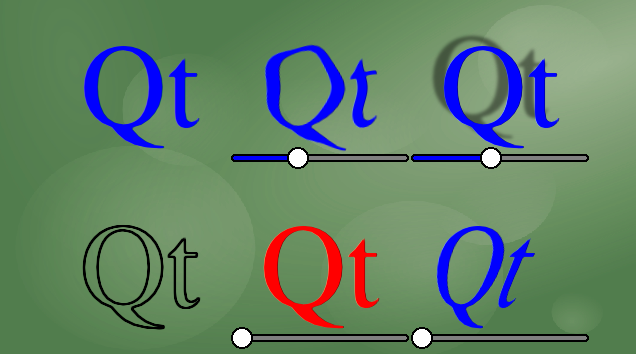Qt Quick Examples - Shader Effects

This example demonstrates a couple of visual effects that you can perform with shaders in Qt Quick. It applies five different effects on a text and a couple of images. For more information, visit Important Concepts In Qt Quick - Graphical Effects
Running the Example
To run the example from Qt Creator, open the Welcome mode and select the example from Examples. For more information, visit Building and Running an Example.
Using ShaderEffect
The ShaderEffect type typically operates on other types, using a ShaderEffectSource:
ShaderEffectSource { id: theSource sourceItem: theItem }
In the above snippet, theItem is the ID of a complex QML object in the file.
ShaderEffects can use this ShaderEffectSource as a texture in their fragment shader:
fragmentShader: "uniform lowp float qt_Opacity;" + "uniform highp float amplitude;" + "uniform highp float frequency;" + "uniform highp float time;" + "uniform sampler2D source;" + "varying highp vec2 qt_TexCoord0;" + "void main() {" + " highp vec2 p = sin(time + frequency * qt_TexCoord0);" + " gl_FragColor = texture2D(source, qt_TexCoord0 + amplitude * vec2(p.y, -p.x)) * qt_Opacity;" + "}"
You can use any custom property on the ShaderEffect in your shader. This makes animated shader code very easy:
property variant source: theSource property real bend: 0 property real minimize: 0 property real side: genieSlider.value SequentialAnimation on bend { loops: Animation.Infinite NumberAnimation { to: 1; duration: 700; easing.type: Easing.InOutSine } PauseAnimation { duration: 1600 } NumberAnimation { to: 0; duration: 700; easing.type: Easing.InOutSine } PauseAnimation { duration: 1000 } } SequentialAnimation on minimize { loops: Animation.Infinite PauseAnimation { duration: 300 } NumberAnimation { to: 1; duration: 700; easing.type: Easing.InOutSine } PauseAnimation { duration: 1000 } NumberAnimation { to: 0; duration: 700; easing.type: Easing.InOutSine } PauseAnimation { duration: 1300 } }
ShaderEffects can also have a custom vertext shader. Setting the mesh property on ShaderEffect provides more vertices for you to manipulate, enabling more effects.
mesh: Qt.size(10, 10) vertexShader: " uniform highp mat4 qt_Matrix; uniform highp float bend; uniform highp float minimize; uniform highp float side; uniform highp float width; uniform highp float height; attribute highp vec4 qt_Vertex; attribute highp vec2 qt_MultiTexCoord0; varying highp vec2 qt_TexCoord0; void main() { qt_TexCoord0 = qt_MultiTexCoord0; highp vec4 pos = qt_Vertex; pos.y = mix(qt_Vertex.y, height, minimize); highp float t = pos.y / height; t = (3. - 2. * t) * t * t; pos.x = mix(qt_Vertex.x, side * width, t * bend); gl_Position = qt_Matrix * pos; }"
Files:
© 2015 The Qt Company Ltd. Documentation contributions included herein are the copyrights of their respective owners. The documentation provided herein is licensed under the terms of the GNU Free Documentation License version 1.3 as published by the Free Software Foundation. Qt and respective logos are trademarks of The Qt Company Ltd in Finland and/or other countries worldwide. All other trademarks are property of their respective owners.
